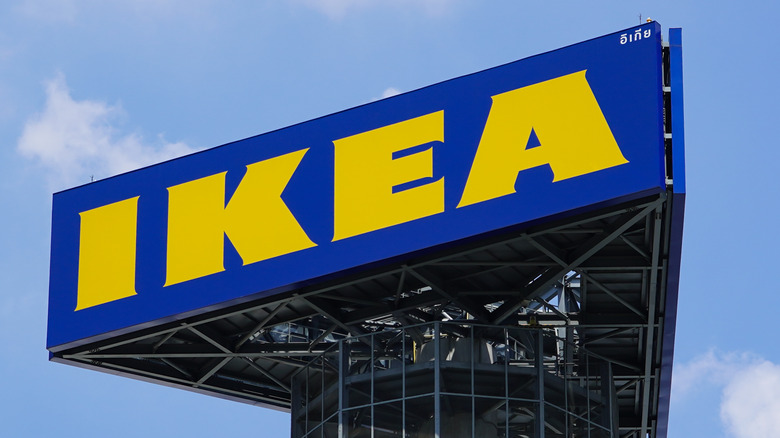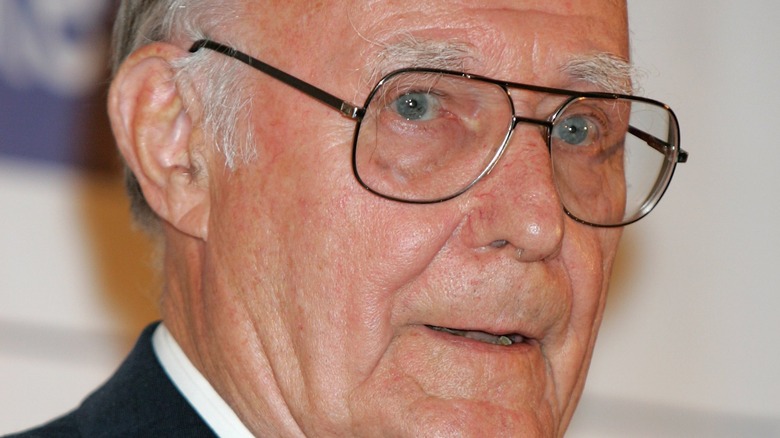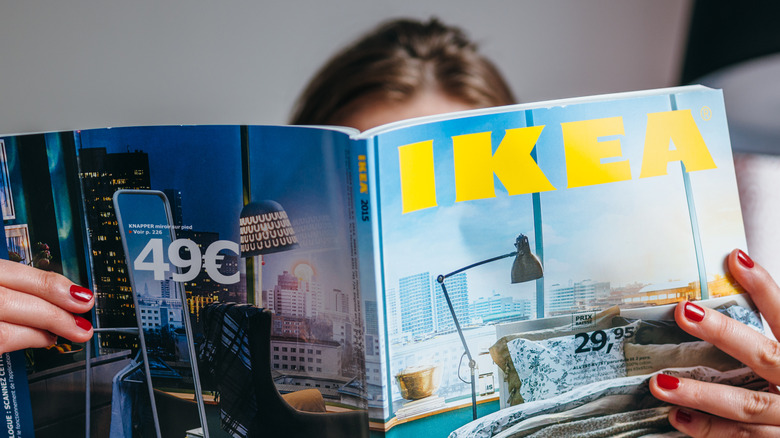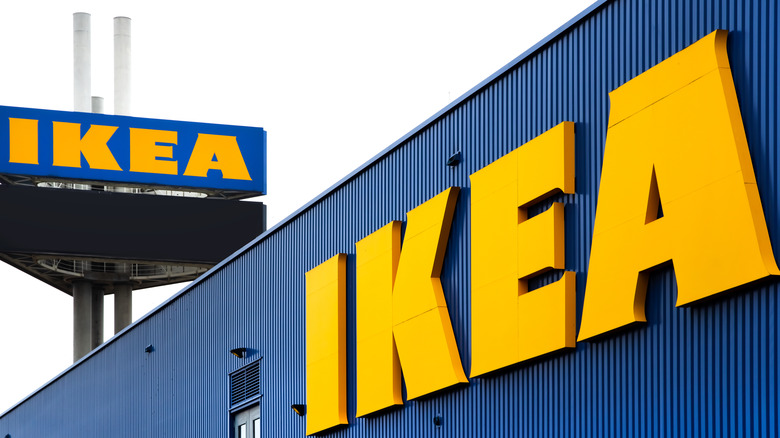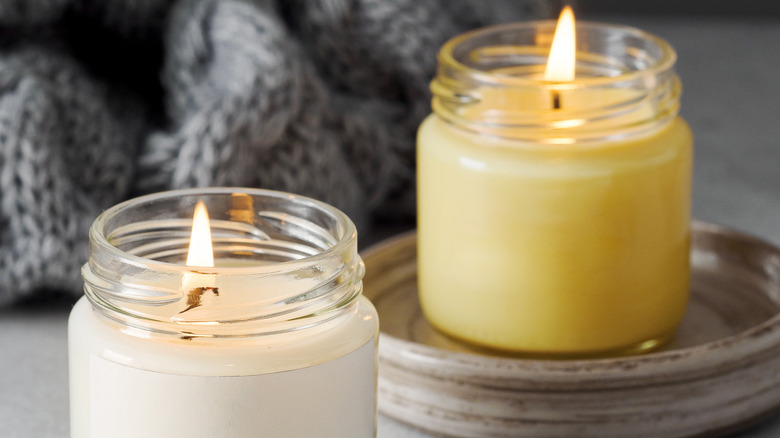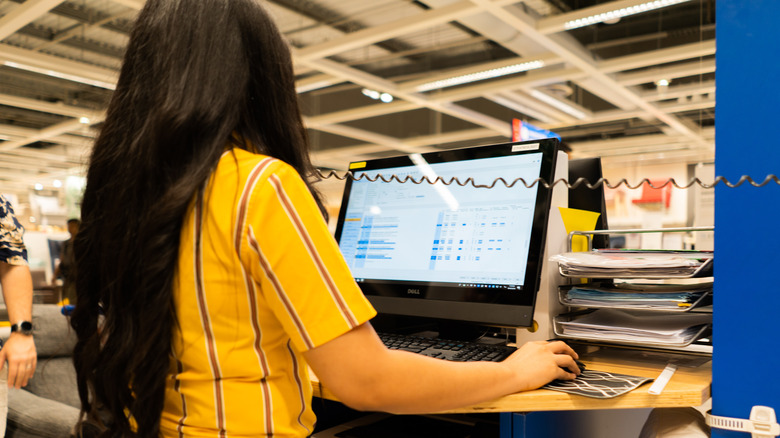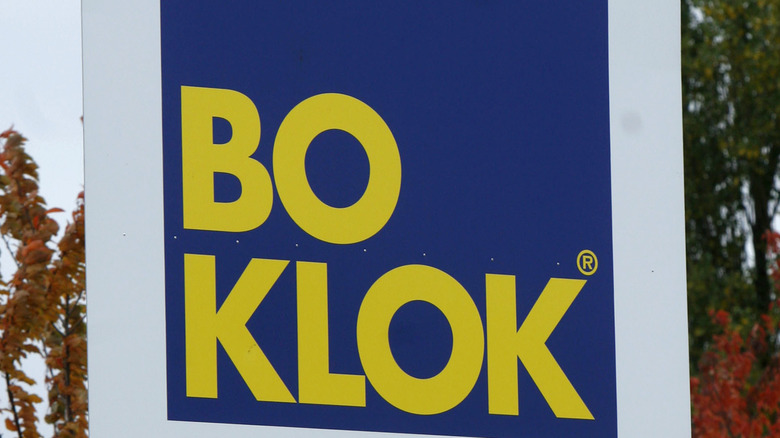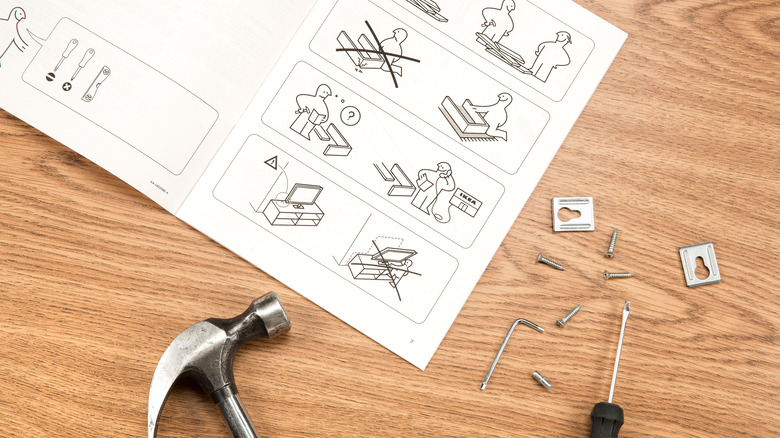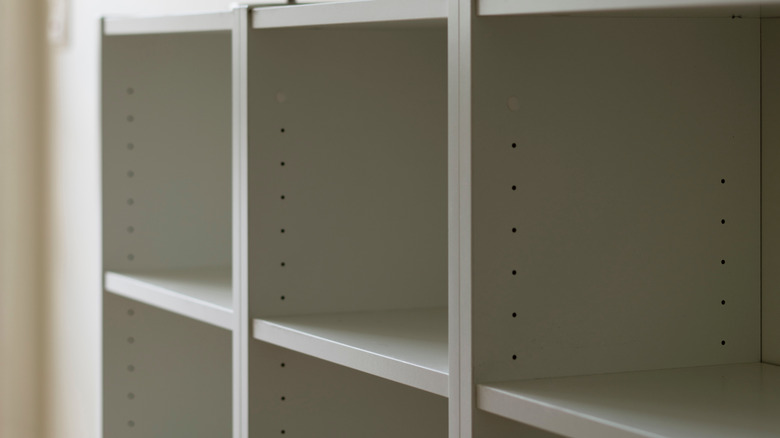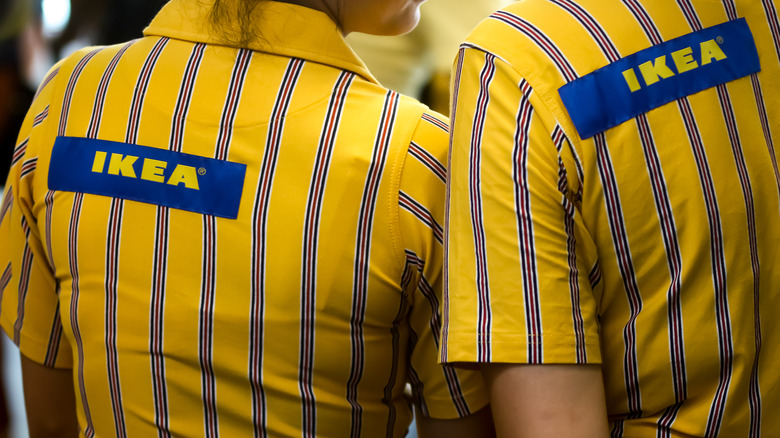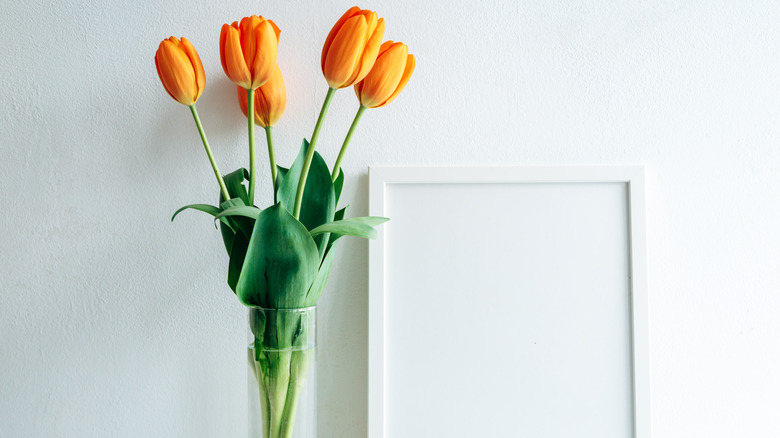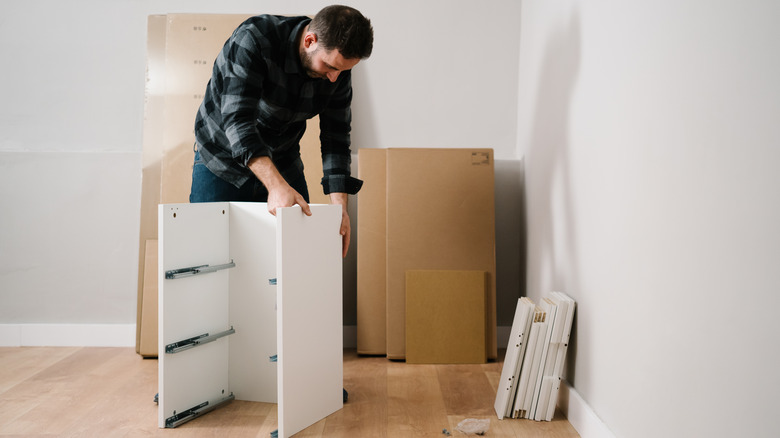What You Don't Know About IKEA
Known for its budget-friendly and stylish furniture, IKEA is a favorite of both college students worldwide and DIYers alike. To some, IKEA is a life-size dollhouse and the perfect afternoon would be spent exploring room upon room of décor ideas, topped off by a visit to the in-house restaurant. But to others, IKEA is a labyrinth of cheap homewares that stinks of meatballs. And in some cases, they would be right, as there are some things you should never buy from IKEA.
No matter what you think of shopping at IKEA, the Swedish superstore boasts many secrets and has an interesting take on global consumerism. It has an eccentric founder, complex business practices, and a unique global implementation of Swedish culture. While it's definitely easy to make mistakes while shopping at IKEA, even if you are its biggest fan, there is still so much to learn about the global Swedish powerhouse. And yes, when you call corporate, the hold music is most definitely ABBA, per the Daily Mail.
Founder Ingvar Kamprad was a frugal billionaire
Ingvar Kamprad was one of the world's richest men for most of his adult life. According to Celebrity Net Worth, his fortune was a whopping $42.5 billion at the time of his death in 2018. However, he never lived a lavish lifestyle and was always careful with his money, choosing instead to maintain the working class lifestyle of his boyhood. Instead of wearing expensive suits, he chose to thrift them (via Culture Trip) and was a fan of continuing to use Sweden's excellent public transportation instead of purchasing an expensive car to get around. By living frugally, he was reportedly able to maintain a strong connection to his employees and better understand the needs of those who shopped in his stores.
In fact, Kamprad's affinity for taking the bus even cost him entry to a Businessman of the Year award ceremony. In a well-known urban legend about Kamprad, he got off the bus and walked to the event's entrance, attempting to enter the ceremony on foot with no fancy transportation in sight, but was refused at the door. Security didn't believe anyone in attendance at such an important event could have possibly taken public transport.
IKEA has a unique product naming system
IKEA is famous for its unique product names, there is actually a strict system to keep everything organized. While every item is an actual Swedish noun, products are grouped after a specific Swedish word based on the type of item they are, as noted by Insider.
For example, outdoor furniture is named after Scandinavian islands and rugs are named after towns in Denmark or Sweden. So the ÄPPLARÖ table range is name for an island in the archipelago north of Stockholm and the LÄCKÖ range comes from an area near Lake Vänern in the country's west. Finally, the HALVED rug, popular for its bright colors and bold design, is named after Halved, Denmark a small town in central Jutland, which is about three hours away from Copenhagen by car.
Shelves are named after occupations or boys' names (BILLY bookcase, anyone?), while fabrics and curtains are female names, like HILJA. So if you're a citizen of Sweden (or elsewhere in Scandinavia) it must be the ultimate achievement to share a name with an IKEA item, or be from one of the selected towns.
IKEA is actually an acronym
While IKEA is famous for its fascinating product names, the name of the store itself actually has a hidden meaning as well: It's an acronym of all the things the retailer's founder held dear. According to the IKEA website, the "I" is for his first name, Ingvar, while the "K" is for his last name, Kamprad. "E" is for Elmtaryd, his childhood farm, and "A" is for Agunnaryd, the closest town to where he grew up.
This very sentimental take further cements Kamprad as a down-to-earth businessman who was appreciative of, and connected to, his small town roots. He grew up on his family's farm in the Swedish province of Småland (also the name of the on-site IKEA nursery) during the Great Depression, and unfortunately IKEA notes that the land was too rocky to be abundantly fertile.
As necessity is the mother of invention, many local families sold homemade housewares or canned food to avoid starvation. Kamprad caught on as a young boy and began doing the same, his first efforts blossoming over the years into a billion dollar business.
IKEA's meatballs have an ulterior motive
Have you ever wondered how exactly lunch at IKEA can be so inexpensive? Well, IKEA actually loses money hand over fist in its on-site café, but it's for a very clever reason: If a shopper is feeling hungry, they might rush through IKEA and not stop to look at everything because their first priority is to leave to get food. And then, if they aren't fed soon, they do just that: They leave IKEA so they can find food.
But the Swedish superstore devised a plan to keep people happy and in the store longer: feed them, as noted by Better Marketing. IKEA believes that hungry shoppers are bad shoppers, but full shoppers are happy shoppers. And happy shoppers spend more time, and therefore more money, at IKEA. The general idea is that the amount of money a customer spends in the IKEA warehouse because they are satisfied and clear-headed due to a good lunch will more than make up for the financial loss the company took on the meatballs.
You can actually buy a meatball-scented candle
IKEA meatballs are iconic, even if the company does take a loss on them. So to celebrate the 10th anniversary of its rewards program (called IKEA Family) in 2021, IKEA released the special edition candle to celebrate: a meatball-scented candle, according to the Food Network. In 2020, while we were all quarantining, the retail giant released the recipe of the famous meatballs so devotees could whip them up at home (via Good News Network). However, IKEA totally outdid itself the very next year when it took home décor to the next level.
The candle was unfortunately a limited release and there's no word yet on whether the item will be a permanent fixture, but it's popularity leans towards yes. In the meantime, if you can't wait to get your hands on one, they do often pop up on Ebay, just for a little bit more than they would ever sell for in store.
IKEA conducts extensive marketplace research
Since 2014, IKEA has annually invested in an extensive customer survey called "Life at Home" to learn more about consumers and how we live. The store wants the skinny about how we use our homes and how we would like to improve them.
Even though IKEA furniture is inexpensive, the research that goes into optimizing each item to maximize its sale potential is anything but cheap. According to Ingka, IKEA doesn't just conduct surveys, the store's research team even visits select customer's homes to document their specific living arrangements and lifestyle needs. Design Boom notes that in 2017, 22,000 people across 22 countries invited IKEA inside their homes to see how they live and document the experience for market research — and the number continues to grow.
The research team's visit inform IKEA's product design in a way that no other market research can, as families can't hide anything on a home visit. Researchers are able to see the space as it is, perfectly imperfect. They can better understand what customers love about their current homes, how they have adapted the space to suit their needs, and how IKEA can stand in the gap between what they already have and their ideal space.
You can actually buy an IKEA house
For the IKEA super fan, it might not be enough to furnish an entire house with IKEA furniture and décor: They might need to take it a step farther and purchase an entire IKEA house. Although it might seem too good to be true, it isn't. The BoKlock is IKEA's answer to budget-friendly, sustainable housing.
IKEA partnered with residential development company Skanska to engineer the wooden homes. To avoid construction problems and to keep costs low, BoKlok homes are built off-site in a controlled environment using state-of-the-art methods of construction and sustainable materials. Once completed, the homes arrive on location and are ready for sale.
To buy a IKEA home, you need to register for a raffle (called a ballot, according to the U.K. arm of Skanska). But even if you don't win, there are still hosts of other prizes to enjoy, like IKEA gift cards, free IKEA design advice, and more. There are currently 13,000 of the homes in Sweden, Finland, Norway and the U.K., with no word yet on further expansion, but the opportunity to live in one of these might be worth a move.
IKEA furniture is used in couple's therapy
IKEA's directions famously have no words; they only have pictures of the tools needed and each step of the process. As IKEA is an international retailer, this cost-cutting measure makes it easier to distribute items worldwide without needing to worry about language translations. But, although this technique means the directions can easily be used in multiple markets, it also makes them difficult for plenty of would-be furniture builders to follow, regardless of any attempts from IKEA to streamline the process, per Fast Company.
Because of this, couple's counselors often assign their clients the task of building IKEA furniture together, as noted by The Wall Street Journal. The exercise is popular as it can serve to increase trust and communication skills between partners as they work together to solve the problem at hand. While IKEA does have a reputation for sparking fights between couples, according to The Cut, it's good to know that the very environment that can cause distress for romantic partners is also instrumental in dissolving it. In fact, IKEA is so instrumental to repairing relationships that in Shanghai, single young adults often visit the store hoping to find their other half (via The New Yorker).
The iconic BILLY Bookcase was designed on the back of a napkin
The BILLY bookcase is by far IKEA's bestselling piece of furniture every year — and it's easy to see why with 110 million units sold since its introduction in the early 1980s, according to The Times. But the iconic shelving unit had humble beginnings on the back of a napkin. According to the BBC, inspiration for the BILLY struck IKEA Designer Gillis Lundgren while he was away from his notepad, so he quickly sketched out his idea on the back of a nearby napkin, lest he forget anything before he got back to his desk and could draw it properly.
Lundgren never could have imagined that his simple sketch would go on to be one of the most purchased items in countries around the globe. In fact, so many families in so many different countries own a BILLY Bookcase, that Bloomberg even uses the worldwide cost of the shelving units to keep track of purchasing power in the aptly-named Bloomberg Billy Bookcase Index. Just in case you were wondering, a BILLY Bookcase costs $50 in the USA, but the same unit sells for £35 in the UK (roughly $46), so Brits can get it just a little cheaper than Americans.
An IKEA ad was the first commercial in the U.S. to feature a same sex couple
A 1994 commercial from the DIY giant showed two men shopping for a dining room table together. It was the first commercial to air in the U.S. featuring a gay couple. However, IKEA was not attempting to pander to the LGBTQ+ community with the ad. In an April 1994 Los Angeles Times article (via Curbed), Peter Connolly, an IKEA spokesperson at the time, informed the paper that, "This is just part of our overall strategy to try to speak directly to all kinds of customers."
The spot features Steve and his partner, who came to IKEA because they were ready for a "serious dining room table." The commercial celebrates the couple's commitment to each other and cements their intentions to build a life together — as the table came with an extra leaf — and the couple notes that having a leaf for your dining room table indicates "staying together and commitment."
Americans thought IKEA vases were glasses
IKEA opened its first store in the U.S. in a shopping mall outside of Philadelphia, Pennsylvania in 1985. Locals were thrilled at the chance to finally have a look at IKEA's stylish European offerings at an affordable price, as the inventory was the same as IKEA's continental locations.
But, as Spoon University reminds us, American portion sizes are usually much larger than those in Europe. So, when the first American customers descended on the store, employees noticed something strange: The flower vases seemed to be flying off the shelves. It was June (via The New York Times), so the need for flower vases made sense for summer bouquets, but not to this extent.
It was difficult to understand at first. However, due to IKEA's extensive market research, the team soon discovered the reason: Customers assumed the flower vases were actually drinking glasses as the actual drinking glasses for sale were too small (per Marketing Society). So, the retailer quickly adjusted its product range to suit the local market and began selling larger drinking cups.
IKEA will buy back unwanted used furniture
IKEA is committed to becoming a fully climate-positive business by 2030, hopefully leading the way for other global retailers to follow. In the store's own words, becoming a climate positive business means it will offset more carbon emissions each year than it produces. While most businesses are striving to become carbon neutral, IKEA is taking it a step beyond.
One of the most concrete things the retailer enacted to meet this goal is creating its trailblazing buyback program, which encourages a circular economy. A circular economy is an economic system that strives to eliminate waste and pollution, circulate products and materials, and regenerate nature, as noted by the Ellen Macarthur Foundation. It's basically the "reuse" in the familiar reduce, reuse, recycle mantra.
The IKEA buyback program encourages customers to "exchange" their older furniture for an IKEA gift card worth a portion of its original cost, instead of sending it to the dump at the end of its lifecycle with them. While this encourages consumers to be more mindful of their waste, it also creates extensive brand loyalty, as the reward for returning an item instead of destroying it must then be spent in-store. In addition to becoming climate positive by 2030, IKEA aims to become a "fully circular business" that same year (via the IKEA Buyback Program).
